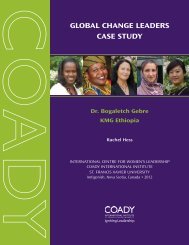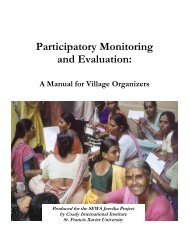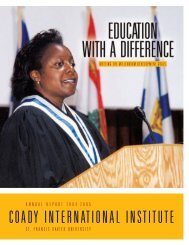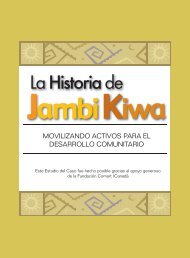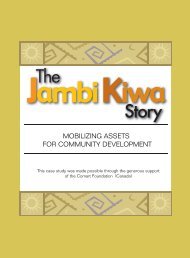Fort McKay First Nation, Alberta - Coady International Institute - St ...
Fort McKay First Nation, Alberta - Coady International Institute - St ...
Fort McKay First Nation, Alberta - Coady International Institute - St ...
You also want an ePaper? Increase the reach of your titles
YUMPU automatically turns print PDFs into web optimized ePapers that Google loves.
fort mCKay fIrst natIon, alBerta 11<br />
meniuk, 2010). And this is just one of the many social benefits related to oil sands development.<br />
<strong>Fort</strong> <strong>McKay</strong> <strong>First</strong> <strong>Nation</strong> has a hundred new three-bedroom houses that the community rents to<br />
its members for far less than market rates. It has a brand new facility that contains the daycare<br />
centre for children and Elders Centre. And while the Band’s plan of building a new K-12 school is<br />
yet to be fulfilled, it has a state-of-the-art eLearning Centre (created jointly with Shell Canada), an<br />
online school providing <strong>Fort</strong> <strong>McKay</strong>’s youth the opportunity to obtain their high school qualifications<br />
within the confines of their community under the <strong>Alberta</strong> Distance Learning Program (<strong>Fort</strong><br />
<strong>McKay</strong> <strong>First</strong> <strong>Nation</strong>, 2011).<br />
Yet these very impressive socioeconomic benefits and entrepreneurial opportunities related<br />
to oil sands development are accompanied by severe environmental deterioration, the full impact<br />
of which on the area’s Aboriginal communities is yet to be determined. There is probably no other<br />
place where the cumulative impacts of oil sands development have been as profound as in <strong>Fort</strong><br />
<strong>McKay</strong>. The most observable environmental effect of oil sands is the loss of huge tracts of boreal<br />
forest. With a footprint of 650 km 2 in 2008 (Schindler, 2010), most of the traplines used by generations<br />
of <strong>Fort</strong> <strong>McKay</strong> people for food and furs have either been wiped out or are no longer accessible.<br />
The impact on forest coverage is expected to rise by almost 20 times – or 11,300 km 2 – dramatically<br />
affecting wildlife and other natural resources. “We are at ground zero,” says band councillor<br />
Mike Orr. “<strong>Fort</strong> <strong>McKay</strong> people are directly affected by industry from all directions more than any<br />
other group” (in Fenton, 2010). The magnitude of the issues requires developing effective mitigation<br />
strategies, and <strong>Fort</strong> <strong>McKay</strong> <strong>First</strong> <strong>Nation</strong> has already taken a number of important steps in that<br />
direction.<br />
One example is the “Healing the Earth <strong>St</strong>rategy,” issued by <strong>Fort</strong> <strong>McKay</strong> Industry Relations<br />
Corporation in 2004, which articulates environmental mitigation practices that the community<br />
expects the industry to adopt. The strategy has four key elements: retention (protecting key natural<br />
areas and life-sustaining resources); reclamation (returning disturbed areas to a state in which<br />
they can support viable populations of traditionally important plants and animals; improvement<br />
(developing environmentally benign technologies); and offset (setting aside existing natural areas<br />
to counteract the deterioration or loss of land due to development pressures). The strategy provides<br />
specific targets regarding air, land, water, wildlife and human health. (<strong>Fort</strong> <strong>McKay</strong> Industry Relations<br />
Corporation, 2004)<br />
Another example is the cultural keystone species model mentioned earlier. Its specific contribution<br />
to mitigating the impact of the oil sands industry on Aboriginal culture encompasses<br />
traditional values and helps community members to maintain spiritual connection with areas undergoing<br />
lengthy reclamation process. This will extend the lives of many people in the community,<br />
providing strong motivation for community participation in reclamation activities.<br />
These examples show that community leaders in <strong>Fort</strong> <strong>McKay</strong> realize the need for bringing<br />
the working relationships they have built with the industry to a new level. The collaborative arena<br />
should be expanded to include concerted land stewardship efforts. “Greater inclusion of the people<br />
of <strong>Fort</strong> <strong>McKay</strong> . . . to regulate and monitor on a <strong>First</strong> <strong>Nation</strong>s environmental stewardship model is<br />
required,” says Mike Orr (in Fenton, 2010). Cecilia Fitzpatrick has a similar vision:<br />
Our people need to be involved. We all need to have a say in how we negotiate with the<br />
industry. Right now our land is being destroyed faster than we can reclaim it. We should<br />
talk to our people about how we should be reclaiming the land. Let’s have scientists talk




